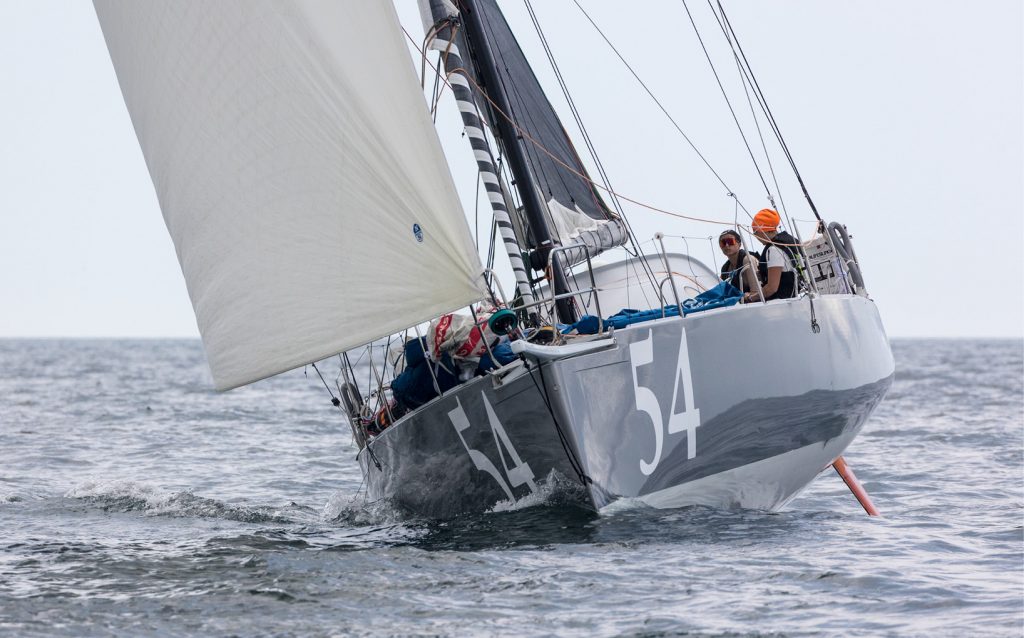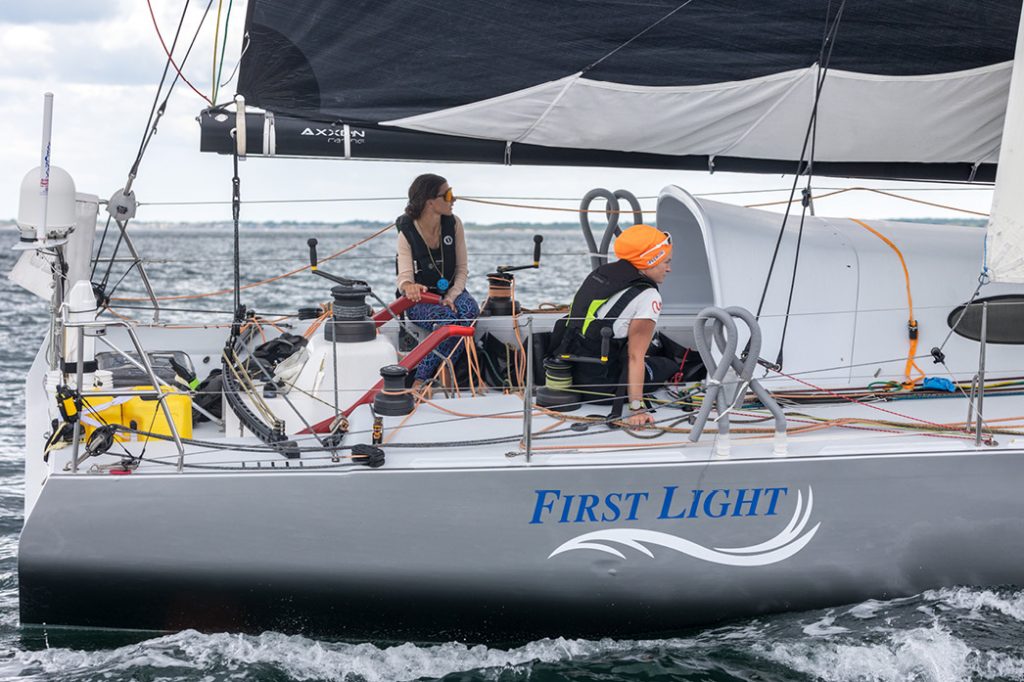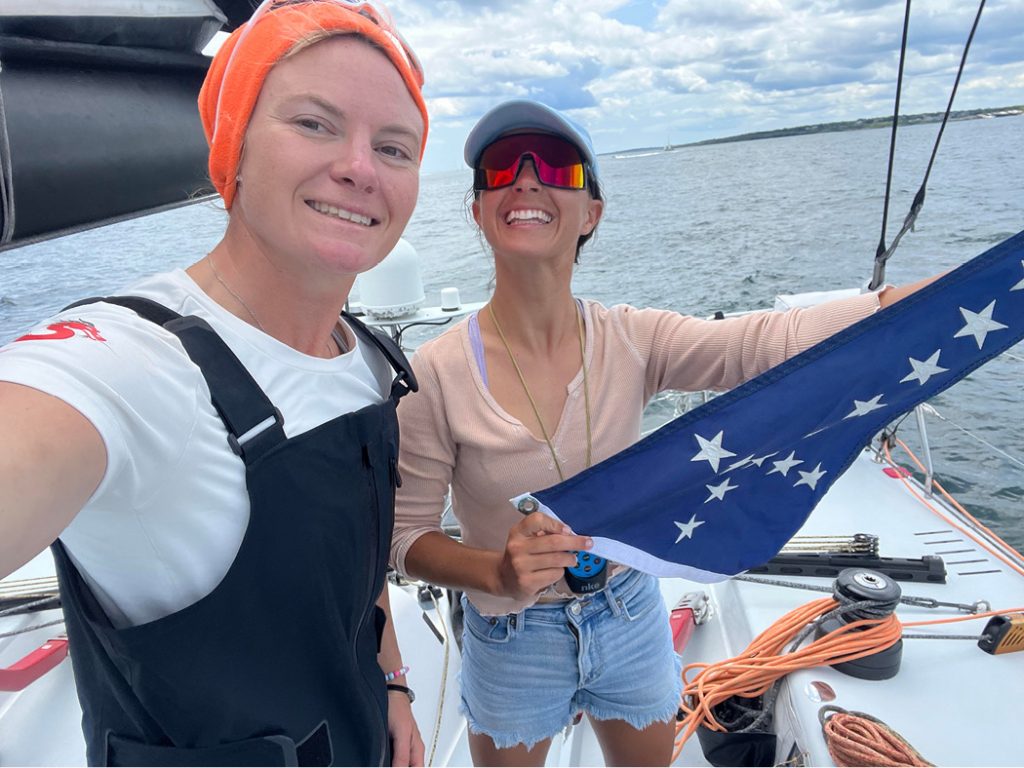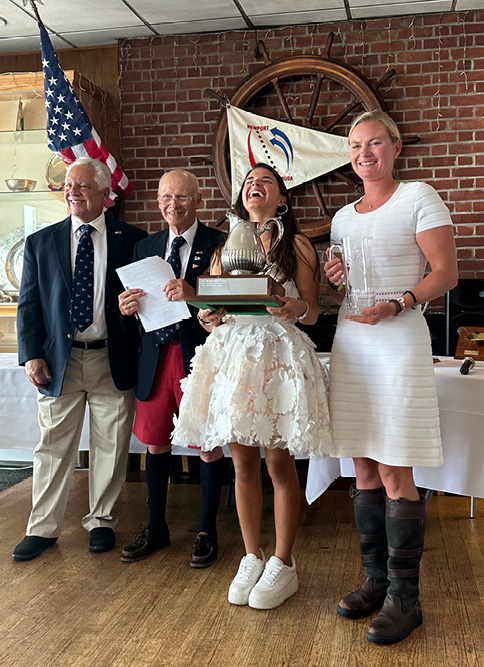By Cole Brauer & Cat Chimney
Editor’s note: In June, Cole Brauer and Catherine Chimney made yachting history as the first women to record the fastest elapsed times in both the singlehanded first leg and doublehanded second leg of this year’s Bermuda One-Two Yacht Race. Young American, a J/105 sailed by Peter Becker and Adrien Blanc, finished a few clicks ahead on corrected time to take first in fleet on Leg 2 of this biennial race from Newport, Rhode Island to the Onion Patch and back.

First Light claimed line honors in both legs of this year’s Bermuda 1-2. © Billy Black/billyblack.com
Leg 1: Newport to Bermuda by Cole
Two years ago, I delivered Dragon the Class40 from Mystic, CT to Safe Harbor Newport Shipyard. I had spent three weeks prepping her for the Bermuda 1-2; adding new sails to the inventory, new runners and checks, and replacing a newly broken spin tack clutch. Two days before the start, I had rigged the boat completely. Sails were in their places, supplies were documented and placed in their zone and even the water bottles were filled. I hoisted the battle flag and stepped off the boat the night before the race.
I was the boat captain of Dragon and Mike Hennessy was to do the solo portion of the 1-2. Mike did an awesome job, winning line honors! I spent the three and a half days watching the tracker like a hawk, making sure that I was on standby for anything that could potentially happen.
I raced the doublehanded portion of the race back to Bermuda with Mike, and we also won line honors. I felt I had prepared the boat for any possible situation and therefore nothing would have stopped us from succeeding. Two years later, Dragon is renamed First Light and now instead of just the boat captain I am also the skipper. It has been a dream to be able to compete on First Light after racing on her since 2019. I know her very well; what she needs and what she doesn’t. Before the start of the 2023 Bermuda 1-2 I set up First Light, once again at Newport Shipyard. We had to do a tip-test and weigh as per Class40 rules of ‘new ownership,’ I had to renew my Safety at Sea certification, and then the race prep process began. Race prep includes spares of everything and every type of tool that I would need while also saving weight. Also organization of these spares to make sure that even when I’m exhausted I can know exactly where that tool part is with my eyes closed.
But not everything was perfect. I had been living in my van for two weeks prepping First Light for the race. I walked down to the boat in my pajamas the night before the start just to turn on all the systems. I leave all the systems on the night or sometimes two nights before just to make sure that everything works. It’s important to know that your systems can last at least a day without glitching. However when I turned on the autopilot and tested it I noticed the rudder reference display wasn’t showing and the autopilot was panicking. Autopilots must have speed (boat speed or SOG) data and also rudder reference (where the rudder is in space) to be able to use the autopilot at all. I called my co-skipper Cat who specializes in NKE electronics and had her come down at 9pm to help get this sorted. We did some routine checks of the rudder reference and autopilot system and realized the reference had died at that moment. We then switched for the spare and called a local marine technician for another rudder reference. It made me nervous because these things don’t give you a warning when they’re about to fail. They just fail. I’m glad we caught it, although I was more nervous than I would’ve liked to be. But once I got to the start I realized I was on my favorite boat doing my favorite thing. I settled in.
First Light sails like a dream, even when in light breeze as on the first night out of Newport. So light that a whale even swam around me and showed me her belly. She followed me as I moved at 1.2 knots trying to point directly at Bermuda. By midnight, I realized that all my departure planning needed to come into effect now. I had been preparing to go west but wanted a sign before I just hightailed it that far from Bermuda. Midnight came and the breeze filled from behind. I hoisted the A2, our largest kite, and we slowly went from 5, 7, then 11 knots. We were off! The next day or so we sailed west of the rhumbline waiting for the next front to hit us. The breeze increased to a beautiful 25 knots and we were comfortably flying.
Before the start of the race I had worked with Chelsea Freas to plan a route. She said, “If you run through the front and are too fast for it, gybe further west,” which I didn’t think would actually happen. However, on the second night I woke up to flogging sails. I got on deck and quickly gybed. I sailed in light breeze for about 10 minutes before getting right back into 30 knots of breeze. I gybed back to point at Bermuda, but gybed too soon and ran right back out of the breeze. I gybed back into the 30 knots and decided I would have to point at Delaware for an hour or so. I texted my mom saying, “Don’t worry, I’m OK. The tracker is going to look really weird.” My mom watches the tracker the entire time I’m offshore so I knew would be concerned. She responded right away, “OK, thank you.”
I felt like I had made a bad decision being so far west, and still fighting two knots of current. The only positive side was that now I was moving at 15 knots and starting to plane, meaning current wasn’t a factor anymore unless I came off the plane. I kept First Light ripping as long as I could. Eventually on the third day the breeze began to die. I downloaded some weather and noticed I needed to continue going west again and not get tricked into getting too close to the rhumbline where there was a huge ridge (hole in the breeze). I made one last move west, after which my entire shore crew team texted and asked, “Everything OK?” They aren’t allowed to assist but they can ask if I’m mentally stable! I followed my gut anyway and it paid off.
I started to get lifted, gradually pointing west of Bermuda, then at the west side of the island, then directly at St. George’s on the eastern tip. I thought I was going to cry. I was finally, after more than three days, pointed at my destination. I spent the next few hours preparing for landing. I like to get everything cleaned up and ready before I hit the dock. I finished in the early evening to a warm welcome from a former client of mine, John Gardner (I used to captain his 50-foot Grand Soliel before he sold it), and E. Michael Jones, a wonderful friend, photographer, and St. George’s Town Crier. I had been thinking about this moment since 2021 when I prepared this same boat for Mike Hennessy to race to Bermuda and now I had the amazing opportunity to finally try it out myself.

After 50 knots in the Gulf Stream, the breeze was agonizingly light near the finish. © Billy Black/billyblack.com

What is so important about all these solo races is that I am never truly alone. I have a strong team behind me. I would like to thank my entire team for the amazing work they did before during and after the race. Cat Chimney and Philip Carlsson who worked 24/7 as my ‘check-in’ shore crew; Jimmy Carolla who prepped all lodging, food and dockage for me in Bermuda,; Zach Mason who sail tested the new North Sails on the boat; Serena Vilage and Will Bomar for being my local North sailmakers to repair and assist me with the new sails; Chelsea Freas for the amazing navigating before both the solo and doublehanded legs; Kyle Wishart from New England Yacht Rigging for making sure the rig was tuned properly; and of course FK Day for seeing the vision. This team has made my dream come alive.
What’s next, you ask? This awesome team and I are embarking on a much bigger adventure: The Global Solo Challenge. Our start is October 28 from Spain. It is a solo, non-stop race around the world, finishing in Spain, and I will do it on First Light. There are many hurdles to get over however my team and I are full steam ahead to be the First American Woman to Race Solo Around the World. Follow me on Instagram @colebraueroceanracing.
Leg 2: Bermuda to Newport by Cat
Since my “On Watch” article in September 2020 I have prepared for and raced the doublehanded leg of the Bermuda 1-2, and one thing has stayed the same: Eighty per cent of offshore races are won or lost before you leave the dock. As an example for Leg 1: Of the twenty-six known competitors twenty-five started. There were two DNCs; one had engine trouble trying to get to Newport and another missed the start with electrical issues. Five boats never made it to Bermuda.
My role during Leg 1 was to serve as safety and shore crew leading up to the race. I managed the safety check-ins with skipper Cole Brauer, coordinated any breakages and procured spare parts to make sure we could be ready to go for Leg 2. Safety was a huge consideration; safety on-board and protocols on shore.
Our preparation for this race started months earlier when we competed in the SORC series in Florida. We worked on our boat handling: tacking and gybing – doing the hard work and comparing our handling to that of fully crewed boats. After every race we would inspect and improve equipment and our processes. We had systems for everything, the location of items, back up systems…If necessary, we could do any task in the dark by feel.
Cole dominated the first solo leg to Bermuda. After all or our preparation, we were ready to push Leg 2. We left St. George’s on starboard and rolled into a perfectly executed gybe as we had done in training to be on port for the next 635 nautical miles. At one point we were leading the fleet by 80 nm – but I’m getting ahead of myself! Leg 2 is split into three parts strategically: Getting away from Bermuda and our competitors, the Gulf Stream entry and exit, then the final push to Newport. We arrived at the Gulf Stream earlier than we thought in the dead of night with a wall of black storm clouds taking away all the light. We were pushing two reefs and a Code 5 when Cole asked my thoughts on a third reef. We were trucking along in a good sail setup, the autopilot was coping, and our weather download suggested this was maximum strength, so I advocated against it – a choice I would regret.

Big smiles at the prizegiving
I woke up to us starting to broach. I instinctively grabbed my headlamp to go on deck when I got thrown to the other side. What happened? We went from a soft broach to a violent Chinese jibe at 18.9 knots. Safety was first: We acknowledged we were both OK but we needed to get the rig stabilized. The running backstays were on the wrong side, the Code 5 was plastered against the rig, water ballast and sails on the wrong side; it was a mess. In the middle of this we realized the A5, which was bagged on deck, was launched over the side in the gybe still attached to the lifeline and was dragging in the water. We clipped it to a halyard to it take pressure off the lifeline – we would come back to it later. We had to get the Code 5 furled and the boat on the correct tack, which took all our strength with furling line now on the leeward side with all the wet sails on it and a winch no longer an option. Once that was done, we unfurled the Solent and tacked the boat back. We got the A5 out of the water enough to for us to winch it back up the halyard and drop it back on deck. These two hours sucked a lot of energy out of us. We pushed the limit and we found it. We dialed it back for another two hours until the sun came up.
The Gulf Stream was not done with us yet. We set the staysail, two reefs – the windspeed was 32 knots and this was a good sail combination for the wind angle. We’d anticipated the small squall we were in and would go back to the A5 – happily its experience as a “drogue” had not damaged it. I watched the windspeed from my bunk as it crept from the high 30s to the low 40s: storm sail and other reef time. I started getting ready to get on deck and when Cole came flying down the companionway. Almost instantly we were in 50 knots. It was not worth the risk to try and change sails. The boat was on her side, still doing 16 knots through the water but feeling relatively secure. We were going to have to stick it out with our biggest concern being the furled A5, still hoisted. I was on watch and an hour later Cole emerged on deck; the A5 had stayed furled. Finally, the Gulf Stream spat us out.
The last third was more mental chess than a physical test. In dying breeze we saw our lead shrink by 30 nm. By the time we were 40nm from the finish line we had outrun what our weather models were predicting. Frustratingly, we were getting headed away from the rhumbline to the finish and our closest competitor Alchemy was getting the wind direction we wanted. Now we were going upwind and if we had to tack for the finish line it would give Alchemy time to catch up.
We held on to the dream that a windshift might come through as long as we could but reality made it clear we had to go backwards to go forwards and we tacked back. For three hours our brains tortured us – this tack could cost us the race. Then we got east of rhumb and tacked back. The final 2 nm to the finish were the most mentally taxing of the entire race. The wind died and kept swirling around. We did five sail changes in the last mile. Just 0.2nm from the finish we parked in no wind. We’d worked so hard for this finish and were bobbing there, eventually making an ungraceful figure-8 and squeaking over the line. To the end we had to fight and push.
After 635nm we won line honors and won our class in Leg 2. We were safe, trusted our systems, and pushed. What we accomplished sank in at different times for both of us on the motor in. At the dock Cole’s parents greeted us and friends met us with food and a helping attitude; we had nothing left in the bank.
On a professional level we want to thank Serena at North Sails, Sailutions, and the American Sailboat Racing Foundation for getting us on the line. On a personal level, there are so many individuals that support us, from past mentors to current shore crew and fellow competitors that push us and give us a sense of community unlike any other sport. ■



